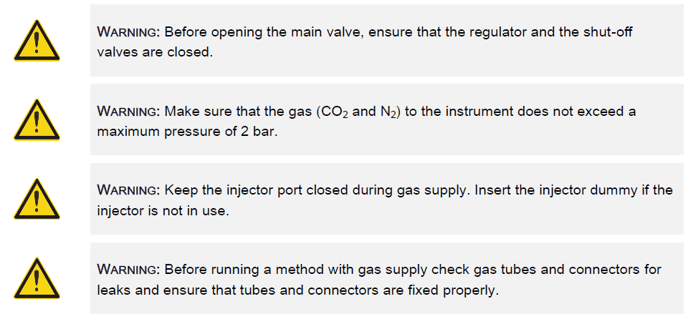Spark®: Specifications for gas used in the Gas Control Module
Which gas quality and additional equipment is needed for carbon dioxide (CO2) and oxygen (O2) regulation?
To control the gas concentration in the Spark® instrument with carbon dioxide (CO2) and nitrogen (N2), gas cylinder(s) or a laboratory gas handling system with pressure reduction valves are required.
Gases: Carbon dioxide (CO2) to regulate CO2 concentration; nitrogen (N2) to reduce O2 concentration (e.g., 50 liter cylinder).
Gas Purity N2 ≥99.9%
Gas Purity CO2 ≥99.0%
The pressure reduction valve must have two gauges – one for the pressure in the bottle (high pressure gauge) and one for the reduced pressure, which should not exceed 2 bar (max 29 psi; low pressure gauge). Ensure that the display for regulating the pressure has a range of 5 bar (72.5 psi) or maximum 15 bar (217.5 psi) to allow accurately regulating pressure between 1 to 2 bar. Make sure that the pressure reduction valve is designed for use with biological applications (ask manufacturer).
The connection from the gas cylinder to the pressure reduction valve is different in each country. Check with a gas cylinder company in your country for the proper connection! Check that the connection piece of the pressure reduction valve matches the inner diameter of the gas tube to the instrument (the inner diameter of this tube is approx. 6 mm). The tube on the connector to the pressure reduction valve must be secured with a plastic clip; a pair of pliers will be necessary to perform this task.
Make sure that there are no bends or kinks in the tubing.
If necessary, convert bar into psi: bar x 14.5 = psi (pounds per square inch)
E.g., 2 bar = 29.0 psi.
To protect the gas cylinder from falling, use a cylinder stand, a table mount (with a securing chain or strap), or a gas cylinder cradle, which can be bought from a gas cylinder company or ordered from a laboratory catalog.

Further help
For further help, please refer to our Helpdesk.
Link to Tecan Product Page
401821-016